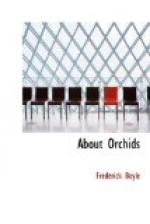In 1889 a collector employed by M. Moreau, of Paris, to explore Central and North Brazil in search of insects, sent home fifty plants—for M. Moreau is an enthusiast in orchidology also. He had no object in keeping the secret of its habitat, and when Mr. Sander, chancing to call, recognized the treasure so long lost, he gave every assistance. Meanwhile, the International Horticultural Society of Brussels had secured a quantity, but they regarded it as new, and gave it the name of Catt. Warocqueana; in which error they persisted until Messrs. Sander flooded the market.
AN ORCHID FARM.
My articles brought upon me a flood of questions almost as embarrassing as flattering to a busy journalist. The burden of them was curiously like. Three ladies or gentlemen in four wrote thus: “I love orchids. I had not the least suspicion that they may be cultivated so easily and so cheaply. I am going to begin. Will you please inform me”—here diversity set in with a vengeance! From temperature to flower-pots, from the selection of species to the selection of peat, from the architecture of a greenhouse to the capabilities of window-gardening, with excursions between, my advice was solicited. I replied as best I could. It must be feared, however, that the most careful questioning and the most elaborate replies by post will not furnish that ground-work of knowledge, the ABC of the science, which is needed by a person utterly unskilled; nor will he find it readily in the hand-books. Written by men familiar with the alphabet of orchidology from their youth up, though they seem to begin at the beginning, ignorant enthusiasts who study them find woeful gaps. It is little I can do in this matter; yet, believing that the culture of these plants will be as general shortly as the culture of pelargoniums under glass—and firmly convinced that he who hastens that day is a real benefactor to his kind—I am most anxious to do what lies in my power. Considering the means by which this end may be won, it appears necessary




